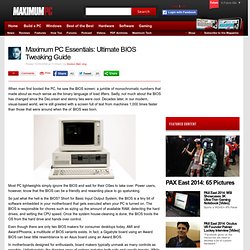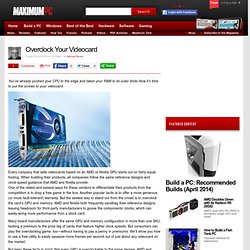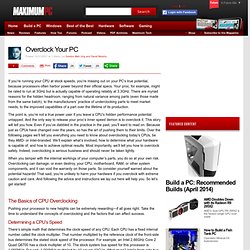

Maximum PC Essentials: Ultimate BIOS Tweaking Guide. When man first booted the PC, he saw the BIOS screen: a jumble of monochromatic numbers that made about as much sense as the binary language of load lifters.

Sadly, not much about the BIOS has changed since the DeLorean and skinny ties were cool. Decades later, in our modern, visual-based world, we’re still greeted with a screen full of text from machines 1,000 times faster than those that were around when the ol’ BIOS was born. Most PC lightweights simply ignore the BIOS and wait for their OSes to take over. Power users, however, know that the BIOS can be a friendly and rewarding place to go spelunking. So just what the hell is the BIOS? Even though there are only two BIOS makers for consumer desktops today, AMI and Award/Phoenix, a multitude of BIOS variants exists. In motherboards designed for enthusiasts, board makers typically unmask as many controls as possible. How do you get into your BIOS? The days of just selecting your RAM speed are gone. Timing Is Everything Watching the Clock.
Overclock Your Videocard. You’ve already pushed your CPU to the edge and taken your RAM to its outer limits.Now it’s time to put the screws to your videocard.

Every company that sells videocards based on an AMD or Nvidia GPU starts out on fairly equal footing: When building their products, all companies follow the same reference designs and clock-speed guidance that AMD and Nvidia provide. One of the oldest and easiest ways for these vendors to differentiate their products from the competition is to drop a free game in the box. Another popular tactic is to offer a more generous (or more fault-tolerant) warranty.
But the sexiest way to stand out from the crowd is to overclock the card’s GPU and memory. AMD and Nvidia both frequently sandbag their reference designs, leaving headroom for third-party manufacturers to goose the components’ clocks, which can easily wring more performance from a stock card. But keep these facts in mind: Not every GPU is overclockable to the same degree. Now you’re ready to begin. Overclock Your PC. If you’re running your CPU at stock speeds, you’re missing out on your PC’s true potential, because processors often harbor power beyond their official specs.

Your proc, for example, might be rated to run at 3GHz but is actually capable of operating reliably at 3.3GHz. There are myriad reasons for the hidden headroom, ranging from natural variance among parts (even those made from the same batch), to the manufacturers’ practice of underclocking parts to meet market needs, to the improved capabilities of a part over the lifetime of its production. The point is, you’re not a true power user if you leave a CPU’s hidden performance potential untapped. And the only way to release your proc’s inner speed demon is to overclock it. This story will tell you how. How To: Benchmark Your PC without Breaking the Bank.